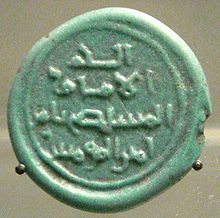Al-Mustadi
| Hassan al-Mustadi Ibn Yusuf al-Mustanjid حسن المستضی بن یوسف المستنجد | |||||
|---|---|---|---|---|---|
| Khalīfah Amir al-Mu'minin | |||||
 Turquoise glass stamp of calif Mustadi 1170 1180 | |||||
| 33rd Caliph of the Abbasid Caliphate Abbasid Caliph in Baghdad | |||||
| Reign | 18 December 1170 – 27 March 1180 | ||||
| Predecessor | Al-Mustanjid | ||||
| Successor | An-Nasir | ||||
| Born | 1142 Baghdad, Abbasid Caliphate now Iraq | ||||
| Died | 27 March 1180 (aged 38) Baghdad, Abbasid Caliphate now Iraq | ||||
| Consort |
| ||||
| Issue |
| ||||
| |||||
| Dynasty | Abbasid | ||||
| Father | Al-Mustanjid | ||||
| Mother | Ghadha | ||||
| Religion | Sunni Islam | ||||
Abu Muhammad Hassan al-Mustadi Ibn Yusuf al-Mustanjid (1142 – 27 March 1180) (Arabic: المستضيء بأمر الله) was the Abbasid Caliph in Baghdad from 1170 to 1180. He succeeded his father Caliph Al-Mustanjid in 1170 as the Abbasid Caliph.
Biography[]
Like his predecessor, he continued to occupy a more or less independent position, with a vizier and courtly surroundings, and supported by only a small force sufficient for an occasional local campaign. During his reign, Saladin ended the Shia Fatimid Caliphate, became the Sultan of Egypt and declared his allegiance to the Abbasids.[citation needed]

Benjamin of Tudela, who traveled to this area between 1160 and 1173, noted: "Two days from Akbara stands Baghdad. The large metropolis of Calif Emir-al-Mumenin al Abassi Amir al-Mu'minin, of the family of their prophet, who is chief of the Mahometan religion. All Mahometan kings acknowledge him, and he holds the same dignity over them which the Pope enjoys over the Christians. The palace of the Caliph at Baghdad is three miles in extent. It contains a large park filled with all sorts of trees, both useful and ornamental, and all kinds of beasts, as well as a pond of water carried thither from the river Tigris; and whenever the Caliph desires to enjoy himself and to sport and carouse, birds, beasts and fishes are prepared for him and for his courtiers, whom he invites to his palace. This great Abassid is extremely friendly towards the Jews, many of his officers being of that nation; he understands all languages, is well versed in Mosaic law, and reads and writes the Hebrew tongue. He enjoys nothing but what he earns by the labor of his own hands, and therefore manufactures coverlets, which he stamps with his seal, and which his officers sell in the public market..."[1]
In 1180, Caliph Al-Mustadi died and was succeeded by his son Al-Nasir.
Family[]
One of Al-Mustadi's concubines was Zumurrud Khatun. She was a Turkish, and was the mother of the future Caliph Al-Nasir.[2] She died in December 1202–January 1203,[3] or January–Febriary 1203,[4] and was buried in her own mausoleum in Sheikh Maarouf Cemetery.[5] Another of his concubines was Al-Sayyida Banafsha.[6] She was the daughter of Abdullah, a Greek, and was Al-Mustadi's favourite concubine.[7] She died on 27 December 1201, and was buried in the mausoleum of Zumurrud Khatun in Sheikh Maarouf Cemetery.[7] Another concubine was Sharaf Khatun. She was a Turkish, and was the mother of Prince Abu Mansur Hashim. She died on 27 December 1211, and was buried in the Rusafah Cemetey.[7]
See also[]
- Ibn al-Jawzi was an Arab Muslim jurisconsult, preacher, orator, heresiographer, traditionist, historian, judge, hagiographer, and philologist.
References[]
- ^ Excerpted from: Komroff, Manuel, Giovanni, Willem van Ruysbroeck, Odorico, and Benjamin. 1928. Contemporaries of Marco Polo, consisting of the travel records to the eastern parts of the world of William of Rubruck (1253-1255); the journey of John of Pian de Carpini (1245-1247); the journal of Friar Odoric (1318-1330) & the oriental travels of Rabbi Benjamin of Tudela (1160-1173). New York: Boni & Liveright.
- ^ Singer, A. (2002). Constructing Ottoman Beneficence: An Imperial Soup Kitchen in Jerusalem. SUNY series in Near Eastern Studies. State University of New York Press. p. 146. ISBN 978-0-7914-5351-3.
- ^ al-Athīr, ʻIzz al-Dīn; Richards, Donald Sydney (2006). Years 589-629/1193-1231. Crusade texts in translation. Ashgate. p. 71. ISBN 978-0-7546-4079-0.
- ^ Ohlander, Erik (2008). Sufism in an Age of Transition: ʿUmar al-Suhrawardī and the Rise of the Islamic Mystical Brotherhoods. Islamic History and Civilization. Brill. p. 92. ISBN 978-90-474-3214-2.
- ^ Hann, G.; Dabrowska, K.; Townsend-Greaves, T. (2015). Iraq: The ancient sites and Iraqi Kurdistan. Bradt Travel Guides. Bradt Travel Guides. p. 146. ISBN 978-1-84162-488-4.
- ^ El-Hibri, T. (2021). The Abbasid Caliphate: A History. Cambridge University Press. p. 231. ISBN 978-1-107-18324-7.
- ^ Jump up to: a b c al-Sāʿī, Ibn; Toorawa, Shawkat M.; Bray, Julia (2017). كتاب جهات الأئمة الخلفاء من الحرائر والإماء المسمى نساء الخلفاء: Women and the Court of Baghdad. Library of Arabic Literature. NYU Press. pp. 66–68. ISBN 978-1-4798-6679-3.
Bibliography[]
- This text is adapted from William Muir's public domain, The Caliphate: Its Rise, Decline, and Fall.
- 1142 births
- 1180 deaths
- 12th-century Abbasid caliphs
- People of the Nizari–Seljuk wars
- Sons of Abbasid caliphs